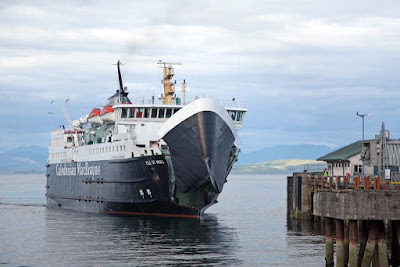
The recent weekend weather in the West of Scotland has not been particularly conducive to sea kayaking. However, this week has been blessed with a high pressure system resulting in light winds, clear skies and hard frosts. Suffering withdrawal symptoms on one of the shortest days of the year, David, Gavin, Harvey, Tony and myself convened at the Ballast Bank in Troon on the Firth of Clyde. Our destination was
Lady Isle which is only 4km away to the south west. Rumours were circulating of mysterious sounds, which locals had heard drifting over the bay from the direction of the island on still nights! We were set to investigate and report back to you, the reader, our findings.
How, may you ask, did we get caught out by darkness on such a short trip? Well we saw no daylight whatsoever. We set off at 8pm which was some four and a half hours after sunset! The temperature then was a reasonable -1.5C but when we returned at 10:30pm it had dropped to -5C.

Navigation was no problem due to the regular white flash (every two seconds) of the lighthouse which is situated in the middle of the island. This was built in 1903 in place of an unlit stone built tower. There is a smaller stone beacon nearby, which was built in 1776 at the same time as the stone tower. The Ayrshire ports were hazardous for sailing ships to enter in strong SW to NW winds. In these conditions ships could find safe anchorage in the lee of Lady Isle by lining up the two stone towers.
The night was clear with a near threequarter waxing gibbous moon. Mars, Orion, the Plough and Cassiopeia were prominent overhead but apart from the flash of the light, the island itself was just an indistinct shadow. As we approached we became aware of a curious bellowing and groaning coming from the island. The source of the mysterious sound was soon discovered. This is the mating season for grey seals and it proved to be in full swing. In the darkness we could see little of the actual events but the sounds were quite self explanatory. After a particularly prolonged roaring between two bulls, the defeated seal made off into the sea with a great splash. To Harvey's great concern he swam straight for us. To the recently defeated bull we might appear as slim and attractive newcomers that might succumb to his needs and desires (all 800lbs of them). We behaved as unseal like and as unfemale like as we could. Neither did we wish to rekindle his fighting spirit by giving more than a passing glance at the shadowy figures of the harem of females waiting for the master.
Last night we fortunately returned to shore as mere observers of, rather than as participants in, the ancient rituals which have been acted for countless generations under the winter moon on Lady Isle. Kayako intacto as they say.
18/1/2007

This photo shows Troon South Beach on 20/10/02. Last night we launched from the distant point. You can just see the lighthouse on Lady Isle at the left of the photo. There is a yacht to its left.

















































